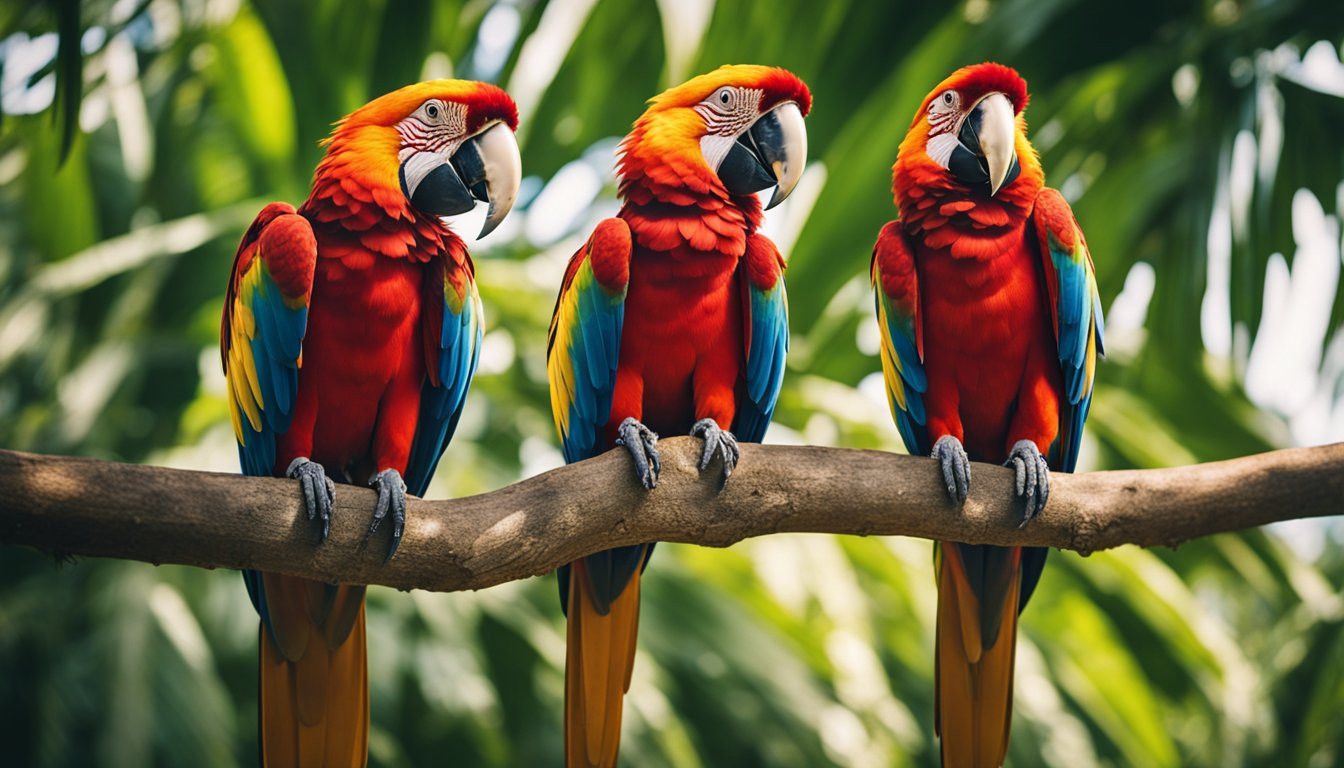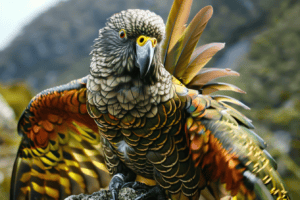Macaws are the flashy show-offs of the bird world, with their rainbow of colors and impressive wingspans that can reach up to 60 inches—that’s as wide as a kindergartener is tall!
When we see these birds, it’s like spotting a piece of the sky that has decided to come down for a visit.
They’re not just pretty faces either; macaws are super smart.
Just like us, they have their own ways of hanging out with friends and family, and they can even mimic human speech.

Now, imagine flying over the lush rainforests of Central and South America, and there they are, the macaws, dotting the canopy with their vivid blues, greens, and reds.
These birds don’t do anything small; they’ve got loud voices to match their flashy feathers, and they aren’t shy about using them.
They chatter with one another, squawk loudly to communicate, and nibble on nuts and fruits they find in their treetop homes.
Macaws play tag in the sky and even have a favorite game of dropping nuts and sticks just to dive after them – how fun is that?
Have you ever wondered what dinner time is like for a macaw?
These giants of the sky have strong beaks that crack open the toughest nuts and seeds like a can opener!
They’re not picky eaters either, snacking on all kinds of fruits and plants, some of which can even be a bit pokey on the outside.
By flying from tree to tree, they help the forest grow by dropping seeds in new places, making them super important for the health of their home.
And guess what? We can help these colorful creatures by learning all about them and how to protect their forests.
So, let’s flap our wings and dive into the world of macaws together!
Exploring the Rainbow: Macaw Colors

Before we dive into the colorful world of macaws, let’s understand that their vibrant feathers are not just for show—they play important roles in communication and survival.
How Macaws Get Their Colors
Have you ever wondered how macaws are like flying rainbows? Their secret lies in something called pigments, which are substances that give things color.
Macaws have a special pigment called psittacofulvin that makes their feathers so red, yellow, and orange.
The really cool part is that this pigment also helps their feathers stay strong and healthy!
For the blues and greens in macaw feathers, it gets even more interesting.
These colors come from the way light reflects off the structure of the feathers, not just pigments.
It’s like when we see a soap bubble creating wonderful colors as light bounces off it.
The light waves interfere with each other, and voila, we see a glorious blue and green that looks like it came straight out of a painter’s palette.
The Spectrum of Macaw Species
Now, let’s take a flight through the different kinds of macaws and their amazing colors. One of the most famous is the Scarlet Macaw.
With radiant reds, sunny yellows, and sky blues, it’s like a sunset with wings.
Then, there’s the Blue and Yellow Macaw; it’s like a piece of the bright blue sky decided to dance with a golden sunbeam.
Did you know the Hyacinth Macaw is the largest of all the parrot species and a gentle giant?
Its deep blue feathers and striking yellow rings around its eyes make it a breathtaking sight. These are just a few of the incredible macaws out there.
Each species has its own unique combination of colors that we could spend all day talking about!
As we learn more about these colorful giants of the sky, we realize how vital it is to protect them and their rainforest homes.
Their bright colors not only bring joy to our eyes but also tell us a lot about their lives in the wild.
Giants of the Sky: Understanding Macaw Size

When we picture macaws, we think of their astounding size and majestic wingspan.
These birds are truly giants of the sky, and it’s fascinating to look at just how big they can grow.
Comparing Macaw Sizes
We’ve got a wide variety of macaw species, and they differ so much in size! For instance, let’s talk about the smallest and the biggest.
The Spix’s Macaw is about as long as a ruler, measuring around 55 to 57 centimeters from head to tail.
On the other end of the spectrum, we have the impressive Hyacinth Macaw, which can grow up to a staggering 100 centimeters in length!
Their beaks are really strong, too—perfect for cracking nuts and seeds.
The Importance of Large Wings
Have you ever wondered why macaws have such large wings? Well, these winged wonders need big, robust wings for several reasons.
One big reason is that these gorgeous wings help them fly long distances to find food and shelter.
If we think about it like an airplane, those wide wings are also important for helping them soar through the sky gracefully, using the air currents to glide with ease.
Don’t you think it’s cool how nature gives them just what they need to survive in the wild?
Macaw Habitats: From Treetops to Awareness

Hey, friends! Did you know that our colorful macaw friends call some of the most amazing places on Earth their home?
We’re about to explore where these birds live and how we are working to protect their homes!
Diverse Ecosystems of Macaws
Imagine living in a tree where the party never ends—that’s what a macaw’s home is like!
These bright-feathered pals are found in various ecosystems across Central and South America.
They love hanging out in rainforests, woodlands, and even savannas. Each of these magical places offers them something special.
Rainforests provide thick canopies for macaws to play hide and seek, while savannas offer wide-open skies for a game of tag in the air.
Have you ever seen a tree that’s taller than a skyscraper? That’s where our macaw friends build their nests—in the highest trees!
Conservation Efforts for Their Homes
Now, let’s talk about how we’re helping our macaw buddies keep their homes safe and sound.
As we turn awareness into action, teams of conservationists are stepping up big time! They’re working to protect and restore macaw habitats.
For example, in Brazil, there’s a project that helps by planting new trees.
It might sound like a small thing, but every tree planted is another home for macaws!
By protecting the forests, we also help lots of other creatures that share the treetops with macaws.
Remember, when we look after the habitats of our feathered friends, we are taking care of our planet’s health too. Isn’t that awesome?
Frequently Asked Questions

We’ve heard many of you chirp with curiosity about these winged wonders, so let’s flap into some common questions about the world’s most spectacular parrots!
What makes macaws the ‘colorful giants’ of the bird world?
We often call macaws the ‘colorful giants’ because they’re some of the most vividly colored members of the parrot family, and they’re also among the largest.
Their feathers bloom in a rainbow of hues, ranging from bright blues and greens to radiant reds and yellows.
Some macaws have wingspans as impressive as a fully grown human is tall, which certainly earns them the title of ‘giants’ in the avian realm.
Can you own one of these exotic birds, and what does it take to care for them?
Yes, we can own macaws as pets, but caring for these exotic birds is a huge responsibility.
They need spacious cages, a diet rich in fruits, nuts, and seeds, and lots of social interaction to stay happy and healthy.
Macaws can live for over 50 years, so we must be prepared for a long-term feathered friendship.
They’re intelligent and sociable, craving attention and mental stimulation, so we have to ensure we spend plenty of quality time with them.
What’s it like to watch macaws in their natural habitat, and where can you find videos?
Watching macaws in their natural habitat is a breathtaking experience; it’s like watching a living, fluttering rainbow glide through the sky.
Their loud calls echo through the forests as they soar above the canopy or gather in noisy flocks.
We can find videos of macaws in all their wild glory on nature channels, wildlife documentaries, and online platforms like YouTube, where numerous bird enthusiasts share their encounters with these magnificent creatures.
How many of these magnificent Spix’s macaws still exist in the wild or in captivity?
The Spix’s macaw is a critically endangered species, with none currently believed to be left in the wild.
In captivity, we’re nurturing a precious few, with numbers estimated to be around 160 individuals, as conservationists work tirelessly to increase those numbers.
Breeding programs aim to reintroduce these rare blue beauties back into their native Brazil with hopes of them thriving once again.
What’s so special about the rarest macaw, and why are its colors unique?
The rarest macaw captures our imaginations like no other — it’s the Spix’s macaw, clothed in an enchanting shade of blue that isn’t just rare in macaws but in the entire animal kingdom.
Their ethereal blue plumage is beautifully contrasted with striking dark lines around their eyes and a curious bare facial patch, almost as if they’re wearing spectacles crafted by nature.
What are the challenges facing the hyacinth macaw, and how can we help protect them?
Our majestic hyacinth macaws, the largest flying parrot species, are facing tough challenges like habitat loss, poaching, and illegal trade.
Their populations have dwindled alarmingly in the wild.
We can help protect these gentle giants by supporting habitat conservation efforts and ethical ecotourism, which raise awareness and fund local conservation initiatives.
Every step we take, no matter how small, can make a big difference in the survival of these awe-inspiring birds.









